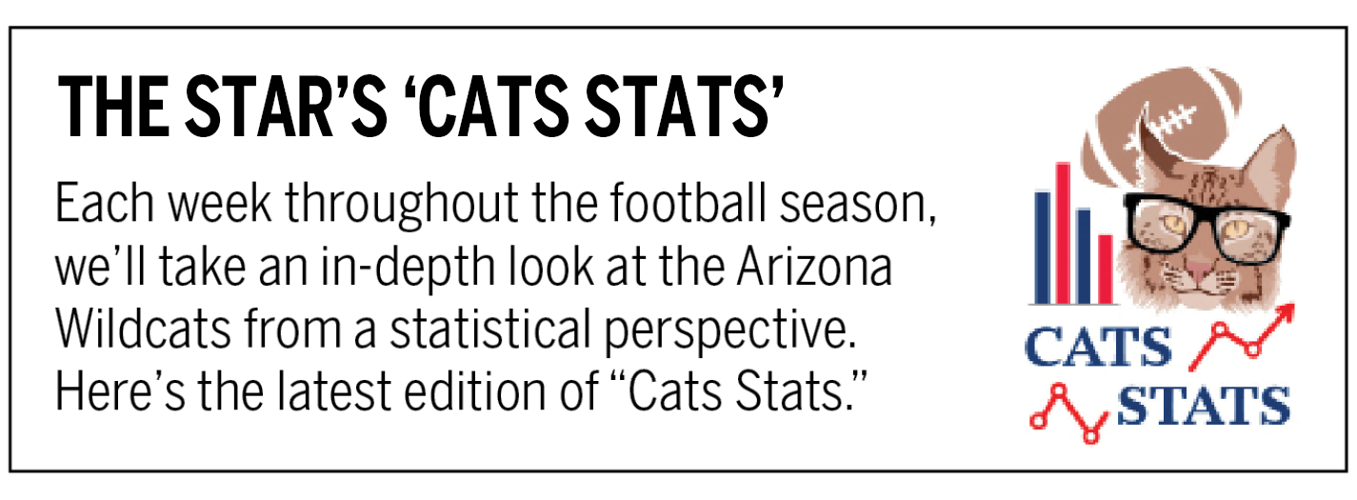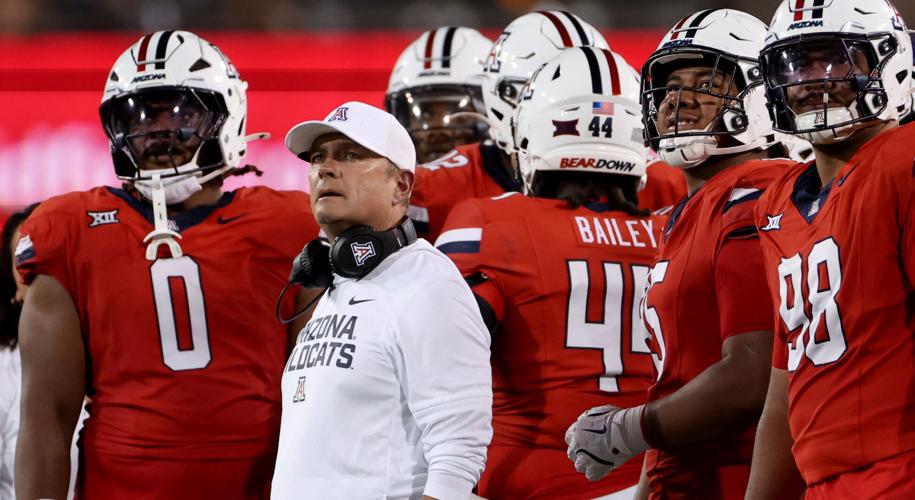By almost every statistical measure, the three best defenses in the Big 12 Conference so far this season belong to Arizona, BYU and Texas Tech.
Two of those teams happen to be facing each other Saturday at Arizona Stadium.

Which one actually has the better defense?
That’s what we’re going to explore in this week’s “Cats Stats.” The answer might surprise you.
At first blush, one would give the edge to the Cougars. They’re first in the league in total defense (239.6 ypg) and second in scoring defense (12.2 ppg). The Wildcats are third (244.8) and fourth (15.6), respectively.
Even if you adjust the latter to account for the pick-six against Arizona last week, the Wildcats are still two points worse per game than the Cougars.
People are also reading…
But we like to dig beneath the surface here at Cats Stats Inc. Other numbers better illustrate the effectiveness of the UA defense under Danny Gonzales.
The statistic most often cited to measure a defense’s worth is yards per play. Arizona has the edge in that category — over everyone else in the conference.

Arizona defensive lineman Tiaoalil Savea storms in to pressure Oklahoma State quarterback Zane Flores into an incomplete pass during the third quarter, Oct. 4, 2025, at Arizona Stadium.
The UA has allowed 3.92 yards per play. Texas Tech is second at 3.94. BYU is third at 4.06. No one else is under 4.50.
If you separate run and pass defense, you can argue that the advantages each side has basically cancel each other out. But we would argue that the gap between BYU and Arizona against the run is narrower than the gap between the Wildcats and Cougars against the pass.
BYU allows 92.2 rushing yards per game and 2.8 per attempt; Arizona is at 96.6 and 3.0. Not much of a difference.
The Wildcats have the No. 1 pass defense in the conference in terms of yards allowed per game (147.2) and per attempt (4.9). The Cougars are barely behind them in the former (147.4). They’re nearly a full yard behind in the latter (5.8).
Arizona also has a sizable edge in completion percentage allowed (51.3% vs. 57.0%) and sacks per game (2.6 vs. 2.0). Overall, the Wildcats spend more time in the opposition’s backfield, averaging a league-best 8.60 tackles for loss per game. BYU is sixth at 6.20.

BYU linebacker Isaiah Glasker (16) tackles West Virginia quarterback Khalil Wilkins (14) for a loss of yardage during the first half of their game, Oct. 3, 2025, in Provo, Utah.
Conversion case
Still not convinced? Let’s dig deeper.
Two areas that are critical to team success are third-down and red-zone efficiency. Arizona’s defense has been better than BYU’s at both through five games.
The Wildcats have allowed opponents to convert 25.7% of their third downs. Only Texas Tech, at 25.4%, has been better in the Big 12. BYU is third at 29.7%.
(In a related development, Arizona has been slightly better at first-down prevention. The UA has allowed 13.2 first downs per game, tied with Texas Tech for the fewest in the Big 12. BYU is third at 14.8.)
Arizona is No. 1 in the conference at keeping the opposition out of the end zone once it crosses the 20-yard line. The Wildcats have allowed a touchdown on only 42.9% of opponent’s red-zone opportunities. The Cougars are tied for fourth in the league at 50%.
Who’s better at taking the ball away? Again, at least so far, it’s been Arizona.

Arizona defensive back Genesis Smith, left, defensive back Marquis Groves-Killebrew, center, and defensive back Dalton Johnson (43) swarm over Oklahoma State running back Rodney Fields Jr. during the second quarter on Oct. 4, 2025, at Arizona Stadium.
The Wildcats average 2.2 takeaways per game, second in the conference behind Texas Tech (2.4). The Cougars are fourth at 1.8.
Even if you include fourth-down stops — Gonzales classifies those as takeaways, worthy of footballs being punctured by the Turnover Sword — Arizona has the edge. The Wildcats have 18 combined takeaways and fourth-down stops, an average of 3.6 per game. The Cougars have 15, or 3.0 per game.
BYU has been better at preventing big plays, but the difference is negligible. The Cougars have allowed 13 plays of 20-plus yards, per , or 2.6 per game. The Wildcats have allowed 14 — 2.8 per game.
The real deal?
Both defenses have been elite at almost all of the above. BYU has a more extensive track record; the Cougars finished first in the Big 12 in total defense and yards allowed per play last season.
As such, it’s reasonable to believe that what BYU has accomplished so far on defense is real — and wonder whether Arizona is due for some regression. The Wildcats are new to this shutdown business, after all.

Arizona defensive coordinator Danny Gonzales and the defensive unit watch the big-screen replays during a review on targeting by linebacker Jabari Mann against Weber State in the second quarter on Sept. 6, 2025, at Arizona Stadium. Mann was eventually assessed the penalty and ejected from the game.
Skeptics also might question Arizona’s schedule so far. “U of A hasn’t played anybody.” About that ...
We looked at three websites that calculate strength of schedule: , and . Arizona’s average SOS on those sites entering this weekend was 91. BYU’s was ... also 91.
Both have faced an FCS opponent from the Big Sky Conference — Portland State (BYU) and Weber State (Arizona). Both have faced a Group of Five foe — East Carolina (BYU) and Hawaii (Arizona). Both have faced a Power Four opponent — Stanford (BYU) and Kansas State (Arizona). Both have played two conference games.
BYU has played one more road game; the ECU contest was in Greenville. Counterpoint: Arizona blew out Hawaii, which defeated Stanford the previous week. And although Stanford has a better record (2-3) than Kansas State (2-4), KSU is considered superior by most metrics. For example, ESPN’s FPI ranks K-State 43rd and Stanford 86th.

BYU's Evan Johnson, right, runs away from East Carolina offensive lineman Jimarion McCrimon after his interception during the first half in Greenville, N.C., Sept. 20, 2025.
BYU coach Kalani Sitake, for one, doesn’t need any convincing. He believes Arizona’s defense is legit.
“Danny’s done a great job with the defense,” . “They tackle well. They’re aggressive.
“Danny’s done a great job everywhere he’s been. He’s from that same lineage as Rocky Long, Bronco Mendenhall and them. So we’re very familiar with the defense.
“But the way he’s able to combine their base coverages with the pressures — he calls a really good game, and he can make things really difficult for any offense. So we’re going to have to be at our best.”

BYU head coach Kalani Sitake protests a call from the sideline during the second half against East Carolina in Greenville, N.C., Sept. 20, 2025.
Contact sports reporter/columnist Michael Lev at mlev@tucson.com. On X (Twitter): @michaeljlev. On Bluesky: @michaeljlev.bsky.social
























